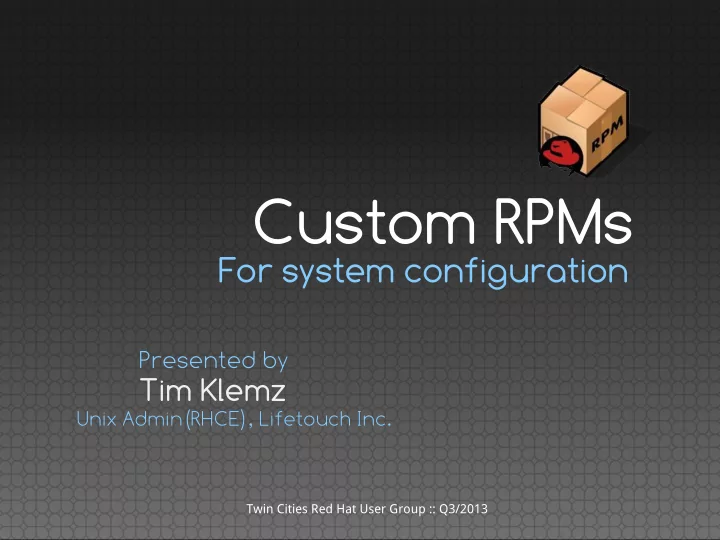

Custom RPMs For system configuration Presented by Tim Klemz Unix Admin(RHCE), Lifetouch Inc. Twin Cities Red Hat User Group :: Q3/2013
Preface 1. I still have lots to learn about RPM creation! 2. RPM's, not unlike scripting, get better with each iteration 3. Lots of resources available – Fedora spec files for examples, RH Summit past presentations.. 4. RPMs are a good stepping stone to puppet configuration management
Today's Topics 1.Really quick RPM primer 2. Why should I use RPM's? 3. Example use cases 4. Breakdown of one of our sample system configuration RPMs 5. Things we've Learned along the way..
● RPM Quick Primer
RPM Quick Primer Create rpmbuild user / group (do not build as root) install rpm package on build server # yum -y install rpm Create rpm directory structure # mkdir -p /opt/rpmbuild/rpm/ {BUILD,BUILDROOT,RPMS,SOURCES,SPECS,SRPMS}
RPM Quick Primer Create structure/files for RPM you are making # mkdir -p ~/rpm/SOURCES/helloworld-1.0/var # echo “hello world” > ~/rpm/SOURCES/helloworld- 1.0/var/helloworld.txt Create the tar.gz of the SOURCE # cd ~/rpm/SOURCES # tar cvzf helloworld-1.0.tar.gz helloworld-1.0/
RPM Quick Primer Create simple spec file to deploy /var/helloworld.txt # cd ~/rpm/SPECS # vim helloworld.spec Name: helloworld Version: 1.0 Release: 1 Summary: Places the helloworld.txt file into /var/ License: Proprietary BuildArch: noarch Source0: %{name}-%{version}.tar.gz %install rm -rf $RPM_BUILD_ROOT <---------exists mkdir -p $RPM_BUILD_ROOT <-------------------Add cp -R * $RPM_BUILD_ROOT <---------------------Add %files /var <----path that the file will end up in once installed
RPM Quick Primer Build rpm # rpmbuild -bb helloworld.spec Once completed, you now have an RPM named helloworld- 1.0.noarch.rpm in ~/rpm/RPMS/noarch/, that deploys the /var/helloworld.txt when installed
● Why Should I Use RPM's?
Why RPMs? Couldn't configurations be done by post install Satellite snippets? What if you are already using configuration management tool (puppet, chef, RH Satellite)?
Why RPMs? Kickstart(Satellite) Snippets are only done on build What if there is a change you wish to make to your snippet? How do you apply that the already deployed systems? What happens is somebody changes a configuration file?
Why RPMs? It's true, configuration management tools can accomplish these same things, but... Although many benefits exist when using a mature configuration management tool... who is at this point? Handle deliberate local configuration changes? RPM's could bridge the gap, and help with logic to later convert tasks to puppet, chef etc...
Why RPMs? Can be installed during a kickstart Can be installed anytime afterwords Can be updated and applied when needed Can setup to address deliberate local configuration changes
RPM Use Cases
RPM Use Cases Biggest use case, Oracle database server builds! Standardized application server builds Reduce build time & hand over servers quicker to end users Handle all configuration changes and server specific application installs in a single “prep” rpm
RPM Use Cases Handle Configuration of system builds User and access configuration Additional applications required (Many requirements for Oracle DB systems!) Application specific kernel parameters Ulimit settings When user access changes, RPM can be updated and applied with a simple “yum -y update”
Example RPM
Example RPM These examples are used to prepare almost all system builds Files to be deployed exist in tarball for RPM in the SOURCES directory We are utilizing RHDS(ldap) for our user management and access control, but proxy/role accounts are local
What We've Learned
What We've Learned Be careful with the “%un” sections in spec file! RPM's are not shell scripts, don't treat them that way Make sure your logic is sound Only use “Requires” for packages that your RPM truly require to operate
What We've Learned Knowing the order of steps for an RPM package update/upgrade is imperative First installs upgrade RPM, then uninstalls original This has major implications! Uninstall directives in spec file are not just used when uninstalling (ie removing) an RPM package %postun says remove oracle user? Upgrade will run and last step will be remove oracle user Overall last steps taken are the “%un” sections from the package you are updating!
What We've Learned When doing “yum update”, order of steps seems like the wrong order(shown on previous slide). This really impacts doing updates when there are commands in the %un sections DO NOT REMOVE A USER IN AN %un SECTION!
What We've Learned Initial RPM's we were making were performing all sorts of seds / echos as if it was a shell script No benefit to use RPM if doing this Difficult if not impossible to upgrade Not able to easily return to previous state when removing the package
What We've Learned Ensure your logic is sound! If there is a mistake in your RPM (especially uninstall sections) you can't fix it once the RPM is installed. Solid logic ensures RPM installs/upgrades and removes without scary error messages Test your RPM for multiple scenarios before rolling it out (install, update, removal)
Summary RPMs can be beneficial when used to perform system configurations Extremely helpful when not (yet) using a configuration management tool When combined with Kickstart, it can makes server setup a breeze
Resources http://www.redhat.com/promo/summit/2010/ presentations/summit/opensource-for-it- leaders/thurs/pwaterma-2-rpm/RPM-ifying- System-Configurations.pdf http://docs.fedoraproject.org/en- US/Fedora_Draft_Documentation/0.1/html/RP M_Guide/index.html
Questions ? Contact: tklemz@lifetouch.com
Recommend
More recommend